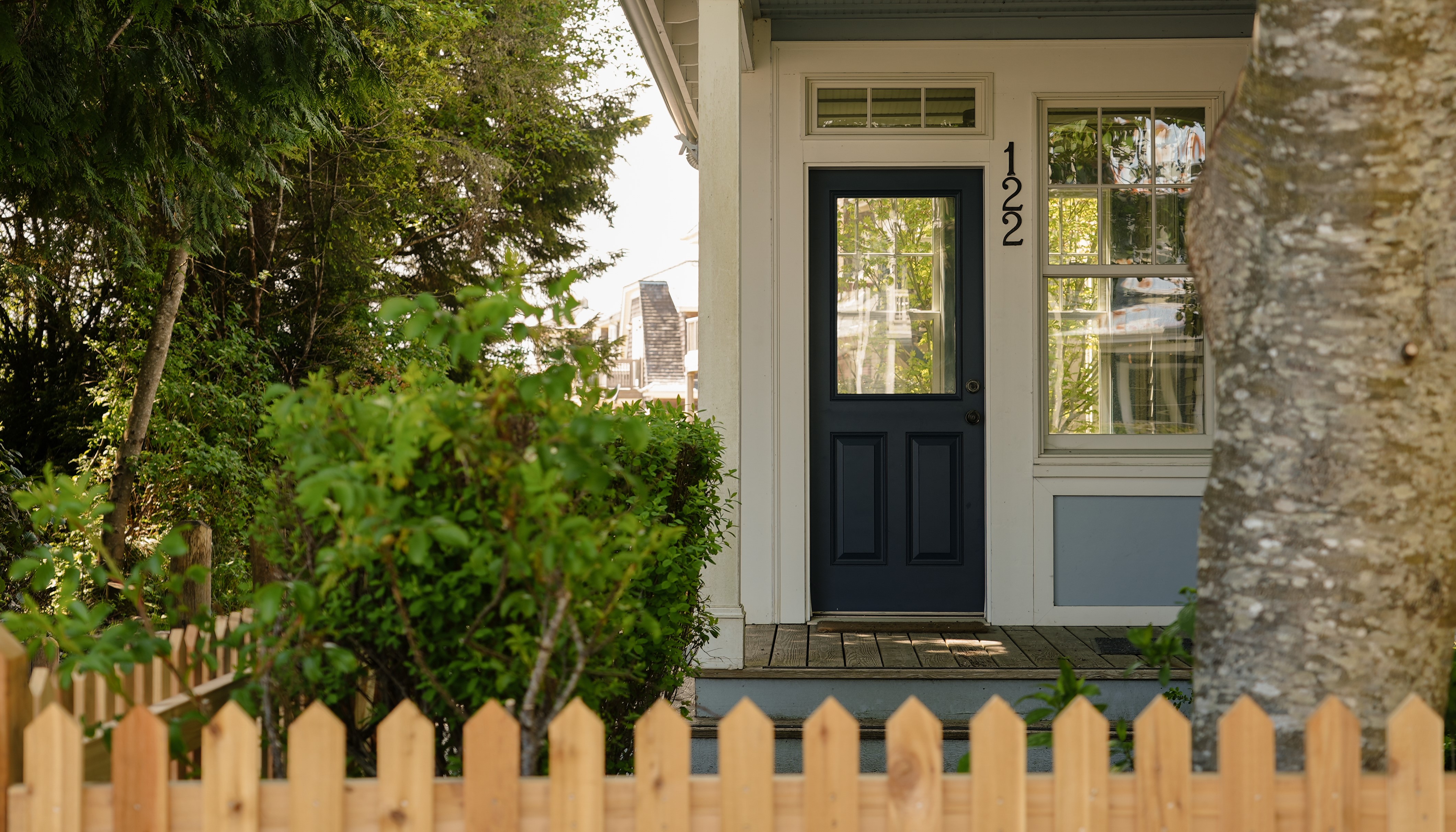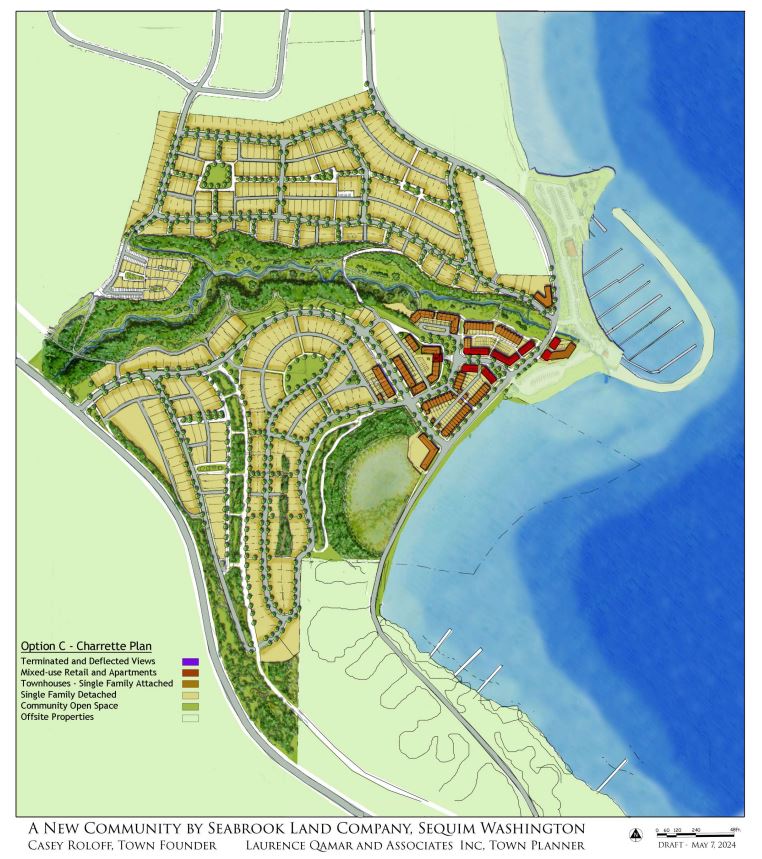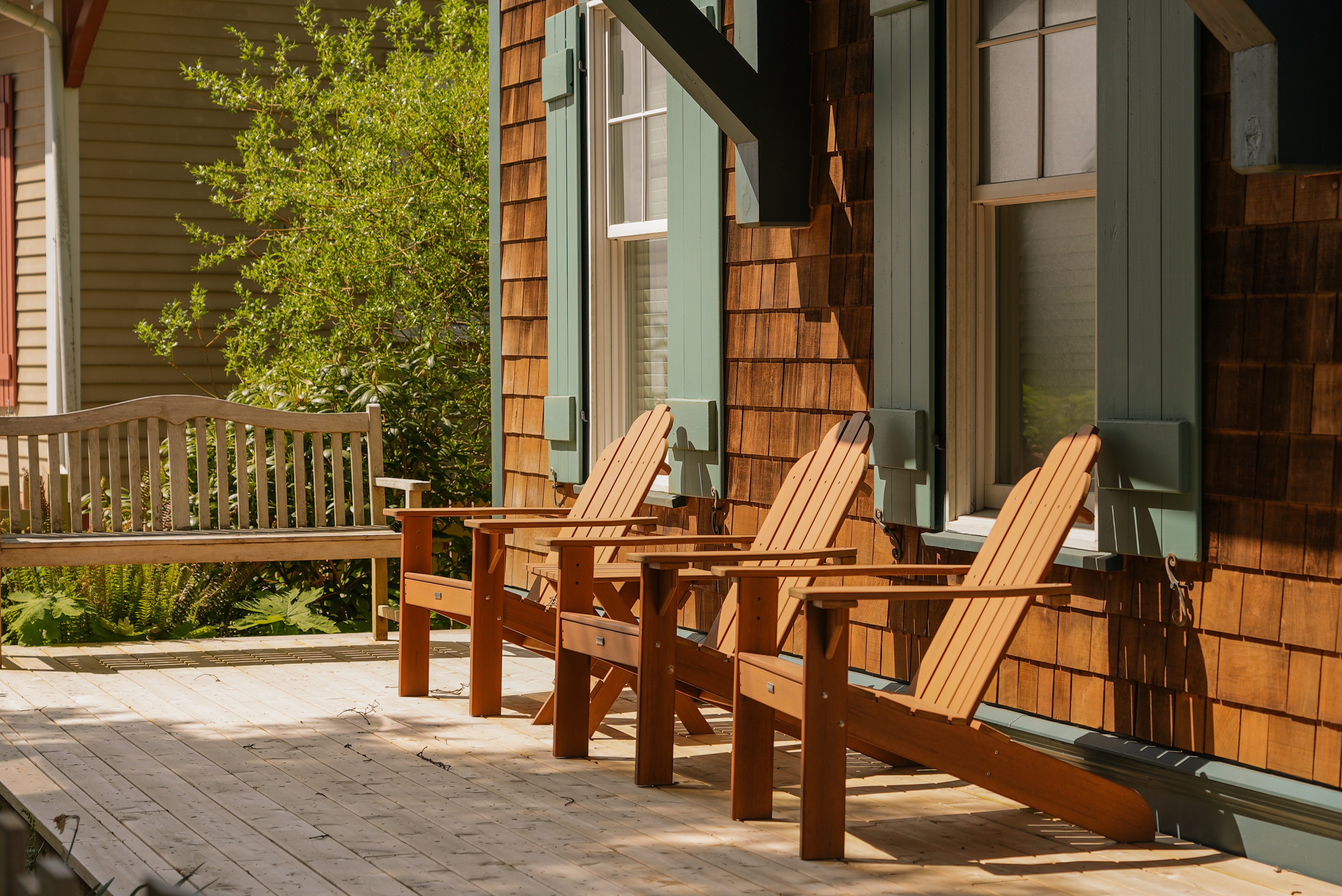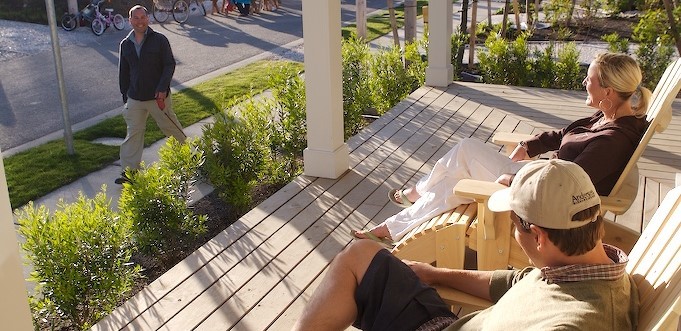Built by the team behind Seabrook, Westbay carries forward a philosophy that real estate development should do more than provide homes—it should create places that bring people closer to what matters.

A New Chapter in Sequim
Tucked at the base of the Olympic Mountains, where the bay meets the horizon, Westbay is more than a neighborhood—it's a vision for living well. Designed with walkability, sustainability, and quality of life at its core, this new addition to sunny Sequim invites you to experience a way of life that feels both fresh and familiar.
With a thoughtful mix of homes, cottages, townhomes, multi-family residences, and timeless architecture, Westbay is a place where front porches and green spaces foster connection. Where wooded trails weave from the forest out to the waterfront and where a vibrant retail hub along the bay anchors the community in daily moments of gathering and discovery.

Built by the team behind Seabrook, Westbay carries forward a philosophy that real estate development should do more than provide homes—it should create places that bring people closer to what matters.

Our carefully planned community integrates residential areas with natural spaces, creating a seamless blend of homes, parks, and waterfront access. The master plan prioritizes walkability and preserves the natural beauty of the Olympic Peninsula.
There's a reason people are drawn to Sequim. With more sun-filled days than anywhere else in Western Washington, it's a natural backdrop for those seeking balance between adventure and retreat, solitude and community. This location is also ideally located an hour and a half from Seattle by ferry for those who want to stay connected to the city. Westbay builds on these qualities, offering a neighborhood that is both deeply connected to nature and effortlessly connected to everyday living.

The best neighborhoods are the ones that feel like they've always been there. Westbay is designed with this in mind. Streets are scaled for people, not just cars. Sidewalks and tree-lined paths lead effortlessly from home to café, from park to waterfront.
Rather than following the typical patterns of development, Westbay embraces a human-centered approach—one that makes it easy to slow down, to walk instead of drive, to exchange familiar hellos at the coffee shop on your way to the shore.
Parks, trails, and waterfront paths weave throughout the community, creating seamless connections between home and outdoors.
Streets scaled for people with sidewalks and tree-lined paths leading from home to café, park to waterfront.
A bayside retail hub offering curated shops, dining, and gathering spaces designed to fit seamlessly into the landscape.
Nature is not an afterthought at Westbay—it's the foundation. Parks, trails, and waterfront paths weave throughout the community, creating a seamless connection between home and the outdoors. The architecture, too, reflects a sense of place—simple, enduring, and deeply rooted in the coastal character of the Pacific Northwest.
This new addition to the bay will be rooted in sustainable practices in form and function. Persevering and enhancing the most sensitive woodlands around the property will allow the creeks, estuaries, tidelands, and woodlands throughout Westbay to thrive and for its residents to enjoy living among them.
From the timeless craftsmanship of its homes to the thoughtful integration of green spaces, Westbay honors the land it's built on. It is a place designed for generations to come, where the surrounding beauty isn't just protected—it's celebrated.

Westbay isn't just another development. It's a reimagining of what master-planned communities can be – bringing back the art of cultivating neighborhoods.
The team behind Westbay, led by Casey and Laura Roloff, is known for bringing vision to life in a way that feels effortless yet deeply intentional. Seabrook's success on the Washington coast has proven that neighborhoods can be built to encourage connection, support local businesses, and enrich everyday life. Now, that philosophy is coming to Sequim.
Westbay isn't new. It's a return to how we used to build new places – designed for people.

We understand that the Westbay neighborhood is generating questions, feedback, and concerns—and we welcome all of it. Our goal is to be transparent at every step of the process. This FAQ was created to clarify key topics and share what we know today. As the proposed new neighborhood evolves, we'll continue to update this page with new information, input from the community, and progress made through the City's review process.
Westbay is a walkable, mixed-use neighborhood proposed along Sequim Bay—designed to reflect the character, values, and natural beauty of the Northwest. Similar to our first community, the town of Seabrook, Westbay will offer a variety of homes, public trails, public parks, and small-scale local businesses, all connected by people-first design. Westbay will be a neighborhood meant to grow thoughtfully over time, with spaces open to all of Sequim and a long-term commitment to supporting the broader community through a dedicated foundation.
Sequim is a uniquely beautiful place with a strong local identity, rich natural surroundings, and a growing need for thoughtful housing. We saw an opportunity to create something that supports the community's long-term vision—a neighborhood that prioritizes walkability, parks, and connection to the land and water.
Westbay reflects its own setting and context. It will be smaller in scale than Seabrook, with a layout shaped by the bay, existing roadways, and nearby neighborhoods. While we bring lessons from Seabrook—like how to build vibrant, walkable places—Westbay is rooted in Sequim's needs and character, not meant to be a copy.
Our goal is to create a neighborhood that feels welcoming, connected, and lived in year-round. That means a mix of homes for different life stages, small-scale local retail, and public spaces where people can walk, gather, and be part of a broader community. Our goal is for Westbay to compliment the City of Sequim, its beautiful main street and surrounding neighborhoods… In other words we want to fit into the beautiful surroundings and be a place where all Sequim residents feel welcome.
Walkable design gives people more choices in how they move, live, and connect. It reduces dependence on cars, improves safety, supports mental and physical health, and brings people closer to the places and experiences they value most. In Westbay, we're applying those principles to create streets and spaces that prioritize people over parking lots.
We see Westbay as a complement to what already makes Sequim great. The plan includes new trails, parks, and gathering spaces that connect with the surrounding area—not close it off. We're designing with the goal of enhancing the community, supporting nearby businesses, and creating shared value for years to come.
No. Parks, trails, streets, and gathering spaces in Westbay will be open to everyone. We believe a great neighborhood contributes to the whole city not just the people who live there.
There is an existing resort on the property that includes an RV park, cabins, and associated open space grass areas. Most of the remaining developable area has previously been cleared and has gravel roads across it. The remaining forest have been harvested multiple times over the years. At Seabrook, we transformed over-logged land into a healthy forested community. We are working with environmental consultants and forest management experts to create a forest stewardship plan balancing housing needs with habitat protection at Seabrook. That same level of care will guide Westbay, ensuring we protect and improve the 50+ acres of preserved forest land for future generations.
Westbay has submitted applications for a Master Plan Overlay and Rezone, which are currently under review by the City of Sequim. Our team has submitted a comprehensive application that was deemed counter-complete, and we're working closely with city staff and planners to refine the details. We're always open to feedback, and we welcome questions or suggestions from anyone who wants to learn more or share their perspective.
We've hosted several town hall meetings at the 7 Cedars and the Marina meeting hall. We've shared the early vision for Westbay, answered questions, and invited open feedback. These conversations and ongoing collaboration with the city continue to shape our approach. We deeply appreciate those who have taken the time to participate. Groups we have met with include:
Sequim Chamber of Commerce, Clallam County Economic Development Council, Puget Sound Anglers – North Olympic Peninsula, Jamestown S'Klallam Tribe (including fisheries, Natural Resources, and Administration), Sequim Bay Yacht Club, Clallam County Fire District, City of Sequim Planning Department, City of Sequim Public Works, Port of Port Angeles, Public Meetings with notifications sent out on local media and mailers to direct neighbors, and Mariners Outlook homeowners.
For more than 20 years, we've been building Seabrook on the Washington coast—a town that's grown from a vision into a thriving, year-round community with over 600 homes, dozens of local businesses, and strong partnerships with nearby towns and agencies. Along the way, we've prioritized quality, character, and transparency—and we've earned a 92% homeowner satisfaction rate as a result. With Westbay, we're applying the same long-term commitment and care to a neighborhood designed specifically for Sequim.
We understand that people are concerned about added traffic, especially near the marina and along West Sequim Bay Road. Our team of professional traffic engineers worked closely with the City of Sequim to prepare a Traffic Impact Analysis (TIA) to ensure that traffic continues to flow efficiently through and around the city. This study modeled future vehicle trips created by Westbay and their effect on 17 existing intersections throughout Sequim. The trip generation assumptions and existing intersections to analyze were reviewed and agreed to by the City Engineer and their traffic engineering consultant.
The final TIA shows that all existing city intersections will continue to operate within an acceptable level of service (LOS) 10 years into the neighborhood build-out and that the Westbay neighborhood will not cause any city intersections to fall below an acceptable LOS at full build-out in 20 years. There are a few existing city intersections that are projected to fall below city LOS thresholds in the 20-year time horizon, even if Westbay is not built. Our understanding from working with the city is that they will address these potential issues in the Comprehensive Plan update they are currently completing.
Yes. Within Westbay's boundaries, we are proposing sidewalks, crosswalks, public parallel parking, street trees, and additional stop signs on West Sequim Bay Road. These improvements (funded by Westbay) will add additional public parking near the marina, improve pedestrian/bike access to the marina property, and reduce speeding on West Sequim Bay Road while only adding seconds to commuters who drive the speed limit.
Within the neighborhood, the street design includes traffic-calming features like narrow lanes, raised crossings, and trail connections to keep it safe for everyone—not just drivers.
Westbay will connect to the city water system, which has ample capacity to serve our new neighborhood and all others projected within the city in the next 20 years. The City's 2024 Water Availability Report notes that only 44% of their current water rights will be used by 2041, including projected growth (including Westbay). The city's 2023 Water System Plan (WSP) additionally notes that there is existing capacity within its current reservoirs to accommodate expected growth. Still, the city is proactively expanding its wells and reservoirs as shown in its Capital Improvement Plan. This expansion has included deeper wells to tap deeper aquifers, which will reduce community demand on the shallower aquifers that many private wells also tap into.
Please see the city's WSP and Water Availability Report for additional details. The city's public works department is also available to answer additional questions.
In addition, a portion of the existing wells within Westbay property will be abandoned, which will reduce the demand on the shallow aquifer under the future neighborhood, benefiting the neighbor's adjacent wells.
Yes, Westbay will connect to the existing sewer system and treatment plant, which has the capacity as shown in the City of Sequim General Sewer Plan.
The neighborhood will create more need for emergency services, but property taxes and connection fees will offset this need. We have spoken to and will continue to work with the city, specifically the emergency service providers, to ensure that Westbay doesn't cause undo strain on the system.
We will be responsible for funding the roads, utilities, stormwater systems, and public spaces that support Westbay—not the City or existing taxpayers. Like at Seabrook, future homeowners will also pay into a Homeowners Association Reserve Fund that covers the long-term upkeep of the neighborhood's privately owned roads (all internal roads at Westbay will be private), public parks, public trails, and landscaping. These privately owned roads and amenities (which will still be open to the public) create less of a tax burden on the city than typical developments since future Westbay residents will still pay taxes for the overall city infrastructure. The city will not need to maintain the private roads and parks within Westbay. The layout of a compact urban development like the one we are proposing with Westbay requires less infrastructure maintenance than typical suburban developments (i.e., less length of roads and utilities to maintain per taxed residential/commercial unit).
In addition to our investment in infrastructure extensions as part of developing Westbay, each new building will be required to pay the City's Water and Sewer General Facility Charges (GFC) of $8,184/ERU for water and $7,548/ERU for sewer. These fees go into a city fund to maintain and expand the systems. These GFC fees for the new neighborhood will add up to approximately $10.5 million.
Westbay will offer a variety of home types, including cottages, townhomes, and accessory dwelling units (ADUs). This range allows the neighborhood to serve many different people—full-time residents, retirees, multigenerational households, and more—at different life stages and income levels.
ADUs provide an additional way for people to live in the neighborhood, even if they're not buying a primary home. They create opportunities for long-term rentals, extended family members, caretakers, or those looking for smaller living arrangements—while still being part of the larger community.
Yes, some short-term rentals will be allowed in the neighborhood. We anticipate that a majority of buyers will be looking to live in Westbay year-round, but we are planning to bring the same award-winning property management approach we have established at Seabrook to the homeowners that do want to rent their home out when they are not there. The Seabrook approach includes on-site staff and safety to ensure full-time residents and short-term rental guests both enjoy their time in Westbay.
By offering a variety of housing sizes and styles, Westbay creates more options without expanding into rural or agricultural land. In addition, each home sale will include a contribution to the Westbay Community Foundation, which can support local housing initiatives. In Seabrook, our foundation has given over $4 million back to the community—and we're excited to see how the foundation in Westbay can partner with local efforts around attainable housing and other pressing needs.
No. Westbay will be fully open to the public. Just like any other neighborhood, all parks, streets, trails, and open spaces will be accessible. We believe strong neighborhoods are built on openness, not exclusivity.
The plan includes a mix of public parks, natural open spaces, and pedestrian-friendly streets. We're also improving access to the Olympic Discovery Trail and exploring options for additional connections and parking near the trail to support broader use.
Yes. The layout is intentionally designed to improve walkability and bikeability around the bay and through the neighborhood—both for residents and visitors. We're coordinating closely with the City to create clear, safe connections.
Yes. While plans are still being refined, the vision includes civic and commercial spaces for community interaction—places where neighbors can gather, shop, or enjoy a coffee together. These areas will be designed to feel local, accessible, and people-centered.
All public trails, parks, and gathering spaces will be clearly signed and maintained for community use. As the neighborhood develops, we'll also share maps, updates, and signage to help residents and visitors make the most of what's there.
Just like we've done in Seabrook, we plan to hire local contractors and tradespeople whenever possible. That means jobs for builders, landscapers, service providers, and others throughout the build-out of the neighborhood. As the neighborhood grows, additional jobs will come through hospitality, property care, retail, and small business opportunities.
The plan includes a small number of commercial spaces—intended to serve the local community, not compete with downtown Sequim. Think cafés, corner stores, or service-oriented shops that make the neighborhood more walkable and vibrant while supporting existing merchants in town.
Every new home will generate property taxes, utility connection fees, and impact fees that go directly into the City's budget. These revenues help support police, fire, public works, schools, and other essential services for the entire community. We're also investing directly in infrastructure and covering the costs of neighborhood operations through homeowner contributions—not public funding.
With each home sale, a portion of proceeds will go to the Westbay Community Foundation—a nonprofit fund that will be dedicated to supporting local needs in Sequim. In Seabrook, our foundation has contributed over $3 million toward education, housing, hospitals, food banks, youth programs, and nonprofit grants. In Westbay, we're excited to partner with local leaders and organizations to shape a foundation that reflects this community's priorities.
No. The marina is owned and operated by the Port of Port Angeles. Westbay is a separate neighborhood nearby. We support the Port's long-term vision for the marina, and look forward to fostering a strong neighborhood connection.
The neighborhood plan was designed to avoid all wetlands, streams, and their required buffers, following the City of Sequim's critical areas code. Johnson Creek and the estuary are both protected features, and we are not proposing any new encroachments. These natural resources will be preserved and respected as part of the neighborhood's long-term layout.
Multiple studies were completed and submitted to the City as part of our application, including:
A critical areas report identifying all wetlands and streams and defining protective buffers, a cultural resources assessment (reviewed by the City, affected Tribes, and the State), geotechnical studies to ensure site stability and safe development, and Phase I and Phase II environmental studies have been completed on this site.
Stormwater will be treated and detained within Westbay (as required by the City and the Washington State Department of Ecology stormwater manuals) before releasing the cleaned stormwater back into the natural drainage ways at pre-development rates. The plan is to match or improve current runoff conditions by using green infrastructure, filtration, and careful grading. Protecting water quality in the bay and creeks is a priority.
No. The neighborhood will include trails and streets designed to improve access—not limit it. Our goal is to make it easier and safer for people to walk or bike around the bay and to the marina, including potential improvements to the Olympic Discovery Trail and other nearby connections.
The permit application for Westbay is still under review by the City of Sequim, so construction cannot begin until all approvals are in place. Once approved, the neighborhood will be built in phases over many years. This allows infrastructure to grow with the community and helps reduce disruption.
Construction vehicles will be routed along Whitefeather Way to Highway 101 to avoid congestion on West Sequim Bay Road. We'll work with the City and contractors to ensure clear signage, safe haul routes, and minimal impact on nearby neighborhoods.
No. Westbay will be built in thoughtfully planned phases over time. This phased approach ensures that infrastructure, services, and community spaces grow in step with the number of homes and residents. It also gives the City and public services time to adapt and respond to real-world conditions.
Yes. We plan to hire local contractors and tradespeople—just as we've done in Seabrook. This not only strengthens the local economy but brings local knowledge and craftsmanship into the neighborhood.
The ongoing care of roads, parks, trails, and shared spaces in Westbay will be funded by the people who live there. It follows a structure similar to what we've used in Seabrook, where over 600 homeowners contribute monthly to maintain and care for public spaces. This approach helps keep the neighborhood clean, safe, and self-sufficient—without relying on the City or taxpayers.
The neighborhood will be overseen by a professional property management team and an HOA board. This model helps ensure that design standards are followed, shared spaces are well cared for, and resident concerns are addressed promptly.
Yes. Like Seabrook, Westbay will use a pattern book and design code to ensure that homes, landscaping, and public spaces are built with long-term quality, character, and consistency. These standards help create a cohesive neighborhood feel. The design code was submitted to the city as part of the MPO application and can be found on the city's website for review.
The neighborhood is being planned in coordination with local fire, police, and emergency services. For example, Mariners View Court will be extended to the new neighborhood as an emergency access point. We're also proposing traffic-calming features to support safer, slower streets that protect pedestrians and cyclists.
It means designing for people—not just cars. In Westbay, streets are sized for slower speeds, homes are close to parks and gathering spaces, and daily errands can be done on foot or by bike. Walkability supports safety, health, and social connection—and creates the kind of neighborhood people enjoy spending time in.
Over the past 20 years, we've learned how to build neighborhoods that grow thoughtfully, connect with nature, and prioritize long-term quality. From trail systems to local businesses to design standards, we're bringing those lessons to Westbay—while shaping everything to reflect the Sequim area specifically.
Typical suburban neighborhoods often separate homes from parks, shops, and services—requiring people to drive for everything. At Westbay, we're aiming for something more connected. By blending homes, green space, and civic areas together, we can support daily life that's more walkable, more vibrant, and more sustainable. In addition, walkable urban developments create more tax revenue for cities than the cost to maintain them. This is due to less public infrastructure (i.e., roads, utilities) being required per unit than in suburban layouts.
The built environment influences how people interact—whether they meet their neighbors, feel safe letting kids play outside, or stay active as they age. We believe thoughtful design can strengthen belonging and well-being. That's why we focus on human-scale streets, inviting public spaces, and a mix of housing types that support real community life.
Success means seeing families walking to the park, neighbors gathering at a local shop, and homes filled with year-round residents who feel connected to the broader Sequim community. It means well-used public spaces, timeless homes, and a neighborhood that adds lasting value to the region—not just real estate.
Stay updated on Westbay's progress and be the first to know about new opportunities in this exceptional community.